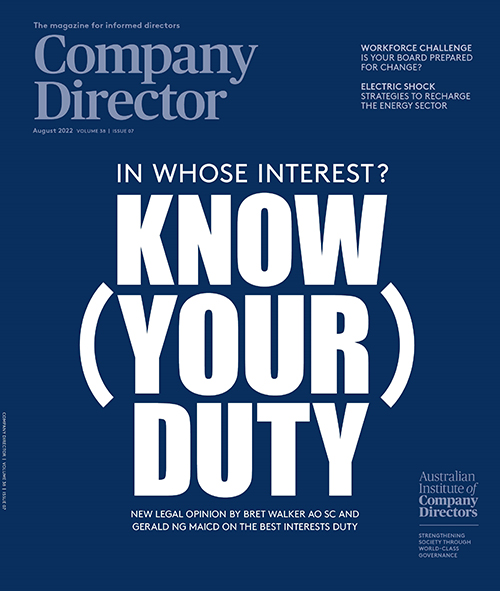It’s hard to say which macro risk is most worrying, inflation, recession or financial crisis — or all three — warns AICD chief economist Mark Thirlwell MAICD.
Inflation, recession and financial crisis comprise a daunting worry list for the global economy. Central banks, including the Reserve Bank of Australia (RBA), are focused on the first item on this agenda — inflation. To this end, at its meeting on 5 July, the RBA board decided to increase the cash rate target by 50 basis points (bp) for a second consecutive meeting, taking it up to 1.35 per cent, its highest level since May 2019. The statement accompanying the decision described the increase as “a further step in the withdrawal of the extraordinary monetary support that was put in place” during the pandemic, and noted that “the board expects to take further steps” in this normalisation process over the months ahead.
When the RBA started the current tightening cycle in May 2022, it did so with a 25bp increase that marked Australia’s first policy rate increase since a similarly sized move in November 2010. Initially, that seemed to signal the intent to return to a “business as usual” approach to the normalisation of monetary policy. Interestingly, the case for this was set out rather nicely in the minutes of the following June RBA board meeting, at which members were choosing between another 25bp increase or a larger 50bp move. Those minutes explain that:
“...a sequence of 25 basis point moves represented a steady approach to withdrawing monetary policy stimulus... appropriate in an uncertain environment... if the cash rate were to be increased by 25 basis points at each meeting over the remainder of 2022, the cash rate would be 2.1 per cent by the end of the year... this would be quite a rapid tightening. While some central banks had been increasing policy rates in 50 basis points increments, [they] meet less frequently than the Reserve Bank board.”
In fact, by that 7 June meeting, the RBA had reconsidered. The board opted to increase the cash rate target by 50bp, something it hadn’t done in more than two decades, since February 2000. The same minutes justify the decision, first noting that the central bank had increased its forecast for year-end inflation, and then arguing that:
“...the level of interest rates was still very low for an economy with a tight labour market and facing a period of higher inflation. Additionally, the inflation mindset in Australia appeared to be shifting. Firms had become more willing to pass on cost increases... employees were demanding higher wages as compensation for higher living costs... there is a heightened risk of persistently high inflation, especially if expectations of higher inflation become entrenched... Raising the cash rate by 50 basis points at the current meeting would help to mitigate this risk.”
The RBA judged that the balance of risks around inflation had shifted, focusing on the danger that high (and expected to be higher — likely seven per cent by year-end) current inflation rates would feed into elevated inflation expectations. That in turn would influence future price- and wage-setting behaviour, risking tipping the economy into a higher inflation equilibrium that would persist beyond the current global disruption to supply chains and commodity markets. To counter that risk, the RBA would be more aggressive, front-loading rate increases.
The 5 July decision to deliver two consecutive 50bp hikes is further confirmation of the RBA’s commitment to this rebalancing of priorities.
It’s a global problem
Martin Place is not alone among the world’s leading central banks in following this plan.
The US Federal Reserve has adopted a similar strategy, albeit against the backdrop of an even greater inflationary challenge. Over the course of three meetings in March, May and June of this year, the Fed has hiked the federal funds target range by 25bp, 50bp and 75bp respectively — a sequence including the first back-to-back US rate increases since 2006, the first 50bp increase since 2000 and the first 75bp increase since 1994. At the time of writing, markets were expecting another 75bp hike at the 26–27 July Federal Open Market Committee meeting.
A more forceful approach has also received the stamp of approval of the central banks’ bank, the Bank for International Settlements (BIS). In the editorial to this year’s flagship Annual Economic Report, the BIS warned that the world economy “may be reaching a tipping point, beyond which an inflationary psychology spreads and becomes entrenched” and that “the long-term costs of allowing inflation to become entrenched far outweigh the short-term ones of bringing it under control”. The consequent policy prescription was a “‘pre- emptive and vigorous response” despite the pain involved.
As the BIS notes, this policy is not without its risks. The preferred outcome is to get inflation under control without triggering a recession. But the BIS accepts that past experience suggests “achieving such a ‘soft landing’ has proved difficult”. Making things even more difficult is the fact that “private debt levels at historical peaks and elevated [asset] valuations could make expenditures especially sensitive... after a long spell of unusually low interest rates and ample liquidity, financial markets could overreact”. That is, aggressive policy tightening risks triggering not just a slowdown in economic activity — even an outright recession — but also financial crisis.
Australian outlook
From an Australian perspective, the good news is that, in many respects, the economy appears resilient. GDP growth held up in the first quarter of this year despite twin assaults from the Omicron variant and severe flooding in Queensland and New South Wales. Household balance sheets look relatively healthy, bolstered by considerably more than $200b of “excess” savings accumulated during the pandemic and a household saving rate — currently roughly double its pre-pandemic average — that still has room to fall. Reflecting that position, the annual pace of nominal retail sales growth is running at around 10 per cent and the level of sales has set three consecutive monthly records. Labour market conditions also underpin household finances, with the unemployment rate at multi-decade lows and the participation rate and employment-to-population ratio both at record highs. There are also healthy construction and investment pipelines. And Australia’s terms of trade recently hit a record high of their own, boosting both mining sector profits and government tax receipts. In this respect, the economy is well positioned to weather higher interest rates.
Still, there are grounds for concern. The latest readings on consumer sentiment tell us that households feel far from confident about the future. That’s no surprise, given a cost of living squeeze that will only be exacerbated by rising interest rates, especially with household debt standing at an eye-watering 187 per cent of disposable income. Falling house prices will further test sentiment — and spending — with the CoreLogic national home value index recording its second consecutive monthly decline in June this year.
But perhaps the most plausible reason for caution is that after two incredibly unpredictable years, it would seem premature to believe that no more unpleasant surprises lie ahead.
Latest news
Already a member?
Login to view this content



